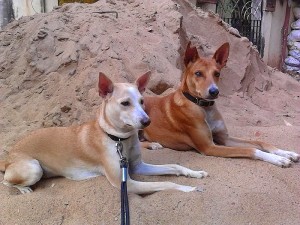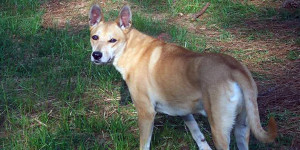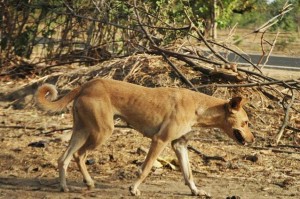
Call us Now ![]() +91-8744012053
+91-8744012053
Mon - Sat ~ 10:00 AM - 6:00 PM
Follow & Like
.png)


Call us Now ![]() +91-8744012053
+91-8744012053
Mon - Sat ~ 10:00 AM - 6:00 PM
Follow & Like
.png)


Those looking to adopt a guard dog that can double as a loyal canine friend, may think of breeds like the German shepherd, Boxer, Great Dane, Doberman amid other options, but why not go for a dog breed that is as native as it can get, the Indian Pariah dog also known as the Pye Dog or InDog can be the perfect pet with all the works. People often confuse every street dog with a Pariah. Many strays are a mixed breed especially in cities where cross breeding with modern dogs takes place, such cross bred canines may be referred as mongrels but are not pure Pariah dogs.

In villages one can find Pariah in its pure form as mating takes place between the same species. It’s an original breed with no intervention by humans in its breeding process. Image: http://breedinfo.ru
It is believed to be a descendant of the very first Chinese dogs that were domesticated and brought to the subcontinent. A recent research highlights another interesting fact, which talks about how Indian sailors brought their dogs to Australia some 4000 years ago, thereby pointing to Australian Dingoes descending from the InDog.
A film by National Geographic Channel, named ‘Search for the first dog’ was based on primitive dog breeds in the world such as the Indian Pariah, Australian Dingo and Canaan Dog of Israel. The short but well researched film rightfully suggests that Indian pariah dogs are one of the ancient dog breeds still found today with a pure bloodline un corrupted for more than 15000 years.

In dog Breed has been also awarded recognition by the primitive and Aboriginal Dog Society (PADS, a global group of dog lovers based in the USA). Image: https://alchetron.com/
The ancient Desi Dog excels as an Indian family pet and here’s why they score over most imported dog breeds.
Pariah dogs adjust well to tropical climate: They are extensively found in India, Bangladesh and Pakistan. They do well in temperatures ranging between -10 to 50 Degrees Celsius. This makes the Pariah adjust well to the Indian Climate that is a mix of winter months and summers. Some regions experience blazing summers. However this breed does not suffer in any way due to weather extremities. When we talk about Great Danes, Boxers, Rottweilers and Doberman Pinschers are some dogs that do not fare well in cold climate. Breeds such as Bull Dogs do not tolerate both hot and cold weather conditions and need special care during extreme weather.
Life expectancy: They can live somewhere between 13 to 15 years of age under congenial and comfortable conditions.
Shedding and Grooming: These dogs shed very little due to a short coat. This also reduces the need for regular combing/brushing of coat. Baths are also an occasional requirement. Drooling does not take place in these dogs. Also naturally they do not have an unpleasant smell of the body. Being a low maintenance dog breed, the owner does not have to loosen his/her purse strings too much. Visits to a grooming parlor are hardly required.
Health: It is a strong breed that rarely gets afflicted with a disease. Under good care this breed can live a long healthy life. Pariahs are a natural dog breed; this makes them free of genetic health concerns such as hip dysplasia that is born out of selective breeding. This breed has evolved over time through natural selection. These Desi canines eat in moderation. Also another plus is they do not snore.
Great Watch Dogs: What makes this breed a great watch dog? For starters, these canines have had a close connection with forests and were originally companions of the aboriginal Indian tribes. They often accompanied the latter on hunting expeditions. Their territorial instinct makes them overly defensive of their pack that could very well be their human family. They are quick at raising an alarm and will start barking at a strange sound/provocation.
A Loyal Breed: Pariah’s association with humans dates back to tens of thousands of years. This ancient indigenous canine companion has always been a part and parcel of human life. They are territorial and devoted towards their family/owners. In rural areas their owners often deploy them to guard farm animals.
Training and Socialization: Early socialization helps in a friendly disposition in general. If introduced to children at a young age, the puppy grows to be comfortable in their company throughout. They are friendly towards their owners however they can show aggression towards strangers/visitors. Therefore it is important to supervise such interactions. When it comes to mingling with other pets/dogs, it becomes important to introduce the Pariah to them when it is still a puppy. Else its aggressive spirit may surface stemming from it being territorial. Hence socializing the puppy will lead to a friendly and caring canine.

The Desi dog is very energetic, intelligent and a fast learner. You can train them easily but the trick here too is to start early. It is important for the dog to consider you as its pack leader. This breed has a tendency to dominate or act stubborn, but these traits can be easily counteracted with early training. Image -mnm.com
Outward Look: Size- It’s a Medium-build dog. Weight ranges between- 14 to 32 Kilograms. Average height is- 2 feet. Common Coat Colors are- pale yellow-brown color, reddish brown, tan and some dogs may have two or more different colors such as hints of white amid a predominantly brown backdrop. Coats that are shaded, spotted or brindled are never found in pure dogs. A solid white coat color too is an indication of cross-breeding. Facial features include a pointed nose/snout and dark brown eyes, appear almond shaped. The ears stand erect and its tail is curled on the back.
Breeding Season: Their mating season is between the months of August to January and the Pariah usually mates once a year.
These dogs have a great deal of positive traits that make them the new prospective pet on the block! Often overlooked as a potential pet, these dogs have existed for more than 15,000 years. They are clever, playful, loyal, and excellent watch dogs. They eat in moderation and their up-keep is simple. So why not fill our households with all the love and much more this breed has to offer.
So, does that mean, if a single guy/girl gets an Indian Dog & let’s say, decide to get married 6-7 years later; the Indian Dog will have difficulty adopting to the changed environment?
No, if you socialize them early, they are very adaptable to new people and situations.